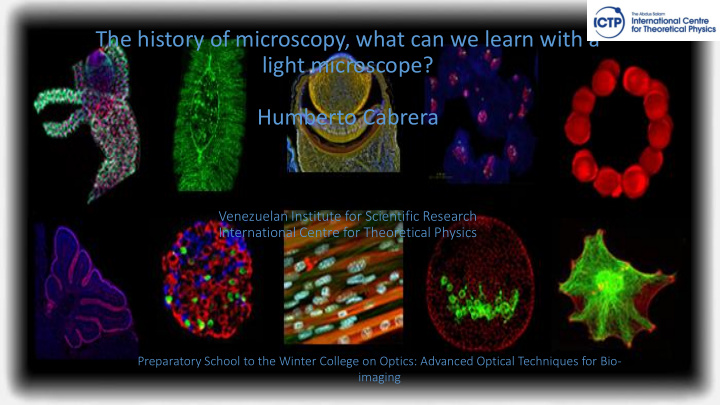



The history of microscopy, what can we learn with a light microscope? Humberto Cabrera Venezuelan Institute for Scientific Research International Centre for Theoretical Physics Preparatory School to the Winter College on Optics: Advanced Optical Techniques for Bio- imaging
Microscopy is often what first captivates kids with science
What the Telescope has done for studies of the universe
The microscope has done for biology S2 cell anaphase
Microscopes allow us to explore beautiful worlds Stephen J Smith - http://www.ncbi.nlm.nih.gov/pmc/articles/PMC 2693015/
“ You can observe a lot just by watching ” Yogy Berra
Microscopes reveal the dynamics of biological systems Immune cells in a lymph node Philipe Bousso
Microscopes reveal the dynamics of biological systems Microtubules and F-actin, newt lung epithelial cell Drosophila embryo mitosis C. Waterman-Storer D. Sharp
Robert Hooke´s cell from cork 1665
Anton van Leeuwenhoek´s “ Animalcules ”, 1676
Walther Flemming pioneer of mitosis, 1878
Camillo Golgi´s silver staining of internal membranes (Golgi apparatus), 1898
Ramon y Cajals´cerebellar neurons, 1905
Shinya Inoue turns to live cell imaging Mitosis in pollen mother cells from easter lilly 1951
Hugh Huxley´s and Andrew Huxley´s studies of muscle contraction Figure from H. Huxley and J. Hanson, Nature 1954
How are proteins and membranes transported in nerve cells? In 1960-70s, axonal trasport was studied primarily by following the movement of radioactively labelled proteins
A revolution in microscopy at the Marine Biological Laboratory: the birth of video microscopy
Video-DIC microscopy of squid giant axon, Allen, Brady Lasek, 1982
Watching biochemistry in action Purified kinesin moving artificial beads along microtubules, 1984 (Ron Vale) https://valelab.ucsf.edu/
Fluorescent Proteins Start a New Revival in Microscopy Shalfie, Shimomura and Tsien Nobel prize in 2008
Mic icroscopy is is constantly advancin ing
Resolution Lim imits of Lig ight
Breaking Resolution Barriers Super-resolution Microscopy Xu K, Babcock HP, Zhuang X, Nature Methods 2012
Breaking Resolution Barriers Super-resolution Microscopy Comparison of the resolution obtained by confocal laser scanning microscopy (top) and 3D structured illumination microscopy (3D-SIM- Microscopy, bottom). Shown are details of a nuclear envelope. Nuclear pores (anti-NPC) red, nuclear envelope (anti-Lamin) green, chromatin (DAPI-staining) blue. Scale bar: 1µm
Manip ipula lations of obje jects, mole lecules and cells lls wit ith lig light Stretching RBCs by optical tweezers. ( a ) Two diametrically opposed silica beads of 4.1 μm are attached onto an RBC surface. ( b ) One bead is trapped by optical tweezers while the other is fixed onto a glass surface. Deformation is achieved by moving the glass surface to the opposite direction. ( c ) Large deformations of RBCs in phosphate buffer saline solution at room Dance of beads temperature are captured by optical micrographs under different trapping forces H. Zhang and K Liu, J. R. Soc. Interface (2008) 5, 671 – 690
Microscopy is making breakthroughs at all scale of biology
Measurements of sin ingle le mole lecule les
Measurements of sin ingle le mole lecule les
We acknowledge Profesor Ron Vale for the material used during the preparation of the lecture https://valelab.ucsf.edu/ https://www.ibiology.org/ibioeducation/taking-courses/ibiology-microscopy-course.html
Thanks
Recommend
More recommend